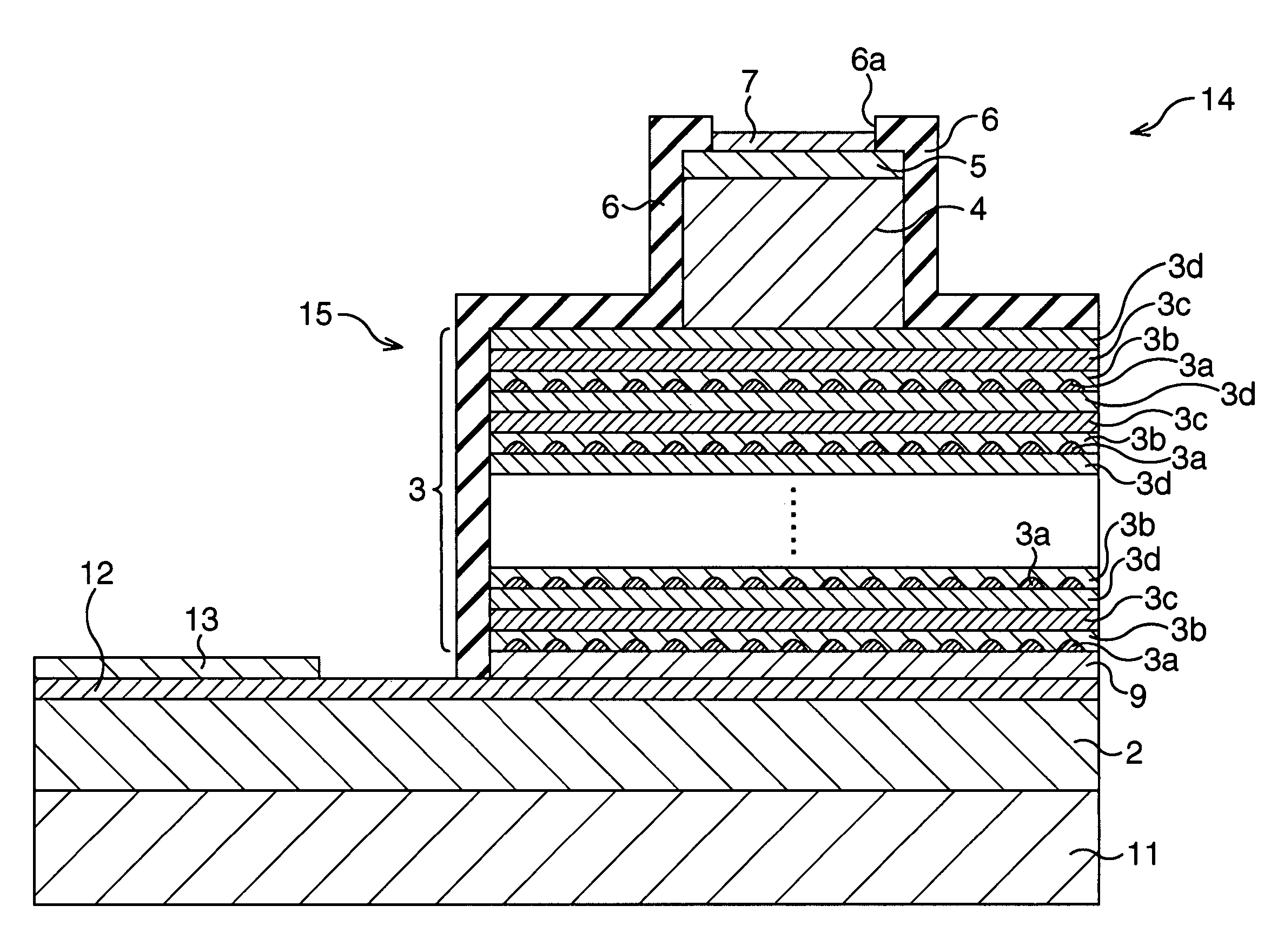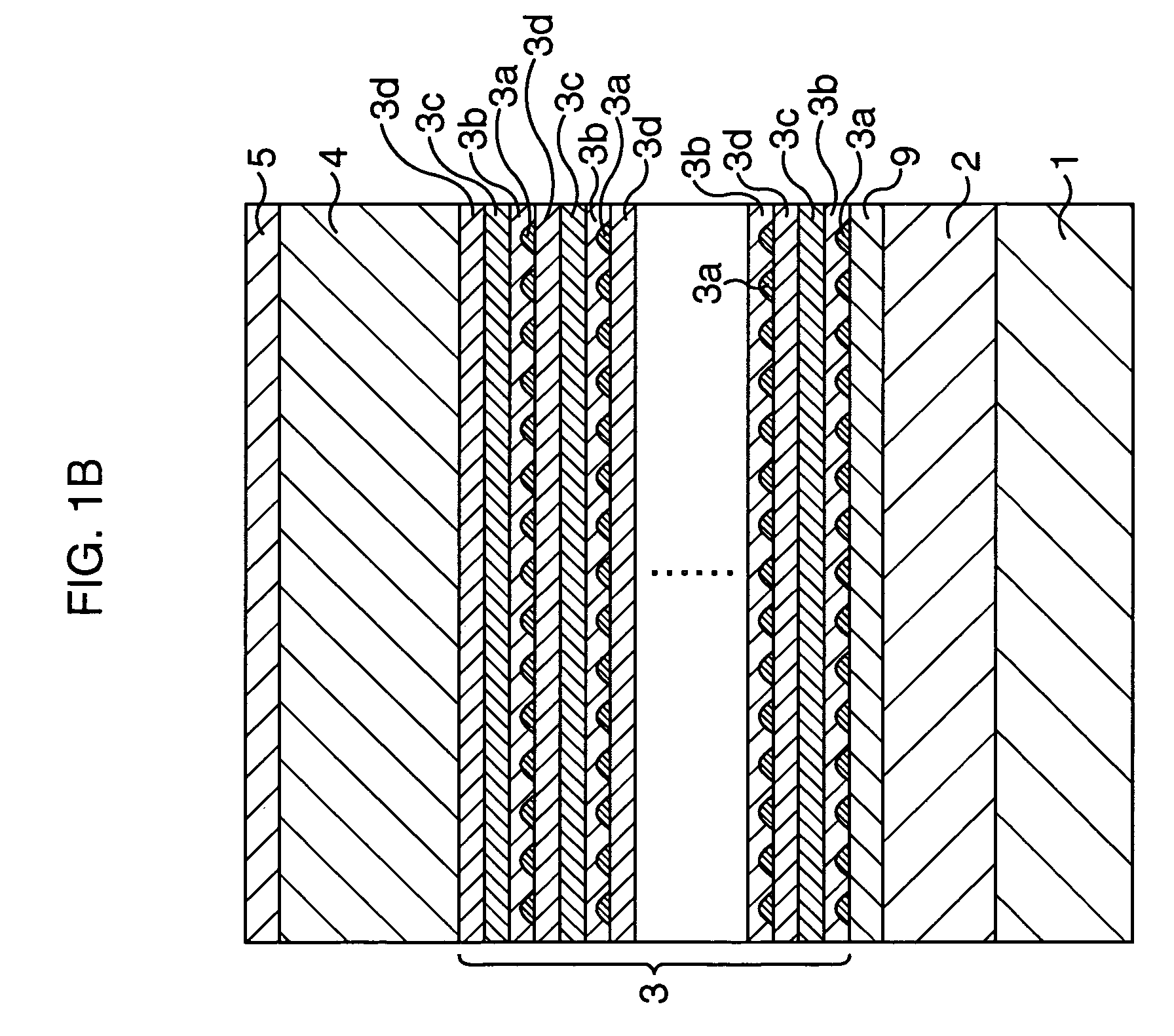Semiconductor laser and method of fabricating the same
a semiconductor laser and laser technology, applied in semiconductor lasers, active medium materials, nanoinformatics, etc., can solve the problems of surface non-radiative recombination, difficult to ensure high-speed modulation operation, etc., and achieve the effect of high-speed modulation operation
- Summary
- Abstract
- Description
- Claims
- Application Information
AI Technical Summary
Benefits of technology
Problems solved by technology
Method used
Image
Examples
first embodiment
[0025]The first embodiment of the present invention will be described. It is to be noted that a structure of the semiconductor laser will be described in conjunction with a method of fabrication of the same for the convenience's sake. FIGS. 1A to 1E are sectional views sequentially showing a method of fabricating the semiconductor laser according to the first embodiment of the present invention.
[0026]In this embodiment, first, as shown in FIG. 1A, a p-type Al0.4Ga0.6As cladding layer 2 and a non-doped intrinsic GaAs waveguide layer 9 are formed in this order on a p-type GaAs substrate 1. The p-type GaAs substrate 1 used herein is such as having a (001) surface, for example. The thicknesses of the p-type Al0.4Ga0.6As cladding layer 2 and the intrinsic GaAs waveguide layer 9 are set to 1.4 μm or around, and 36 nm or around, respectively.
[0027]Next, a p-type quantum dot active layer 3 is formed on the intrinsic GaAs waveguide layer 9. Formation of the p-type quantum dot active layer 3 ...
second embodiment
[0037]Next, paragraphs will explain the second embodiment of the present invention. The description here will be made mainly on aspects different from those in the first embodiment. FIG. 2 is a sectional view showing a semiconductor laser according to the second embodiment of the present invention.
[0038]In the second embodiment, first, as shown in FIG. 2, the p-type Al0.4Ga0.6As cladding layer 2 and a p-type GaAs contact layer 12 are formed in this order on a n-type GaAs substrate 11. The n-type GaAs substrate 11 used herein is such as having a (001) surface. It is also allowable to use a high-resistivity GaAs substrate, in place of the n-type GaAs substrate 11. The thickness of the p-type GaAs contact layer 12 is 0.4 μm, for example.
[0039]Next, similarly to as described in the first embodiment, the intrinsic GaAs waveguide layer 9, the quantum dot active layer 3, the n-type Al0.4Ga0.6As cladding layer 4 and the n-type GaAs contact layer 5 are formed in this order on the p-type GaAs...
third embodiment
[0042]Next paragraphs will describe the third embodiment of the present invention. FIG. 3 is a sectional view showing a semiconductor laser according to the third embodiment of the present invention.
[0043]In the third embodiment, an n-type Al0.4Ga0.6As cladding layer 4a is formed on the quantum dot active layer 3. The thickness of the n-type Al0.4Ga0.6As cladding layer 4a is set to 150 nm, for example. An n-type AlAs layer 21 is formed on the center portion of the n-type Al0.4Ga0.6As cladding layer 4a, and an AlAs oxide layer 22 is formed around the n-type AlAs layer 21. The thickness of the n-type AlAs layer 21 and the AlAs oxide layer 22 is 30 nm, for example. An n-type Al0.4Ga0.6As cladding layer 4b is formed on the n-type AlAs layer 21 and the AlAs oxide layer 22. The thickness of the n-type Al0.4Ga0.6As cladding layer 4b is 1.25 μm or around, for example. Other configurations are same as those in the first embodiment.
[0044]In thus-configured third embodiment, the n-type AlAs la...
PUM
 Login to View More
Login to View More Abstract
Description
Claims
Application Information
 Login to View More
Login to View More - R&D
- Intellectual Property
- Life Sciences
- Materials
- Tech Scout
- Unparalleled Data Quality
- Higher Quality Content
- 60% Fewer Hallucinations
Browse by: Latest US Patents, China's latest patents, Technical Efficacy Thesaurus, Application Domain, Technology Topic, Popular Technical Reports.
© 2025 PatSnap. All rights reserved.Legal|Privacy policy|Modern Slavery Act Transparency Statement|Sitemap|About US| Contact US: help@patsnap.com



